
Romania is a country located at the crossroads of Central, Eastern, and Southeastern Europe. It borders Bulgaria to the south, Ukraine to the north, Hungary to the west, Serbia to the southwest, Moldova to the east, and the Black Sea to the southeast. It has a predominantly temperate-continental climate, and an area of 238,397 km2 (92,046 sq mi), with a population of 19,892,812 inhabitants (2023) made by macrotrend and worldometer. Romania is the twelfth-largest country in Europe and the sixth-most populous member state of the European Union. Its capital and largest city is Bucharest, followed by Iași, Cluj-Napoca, Timișoara, Constanța, Craiova, Brașov, and Galați.
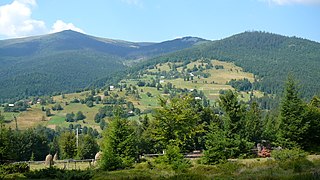
Transylvania is a historical and cultural region in Central and Eastern Europe, encompassing central Romania. To the east and south its natural border is the Carpathian Mountains and to the west the Apuseni Mountains. Broader definitions of Transylvania also include the western and northwestern Romanian regions of Crișana and Maramureș, and occasionally Banat. Historical Transylvania also includes small parts of neighbouring Western Moldavia and even a small part of south-western neighbouring Bukovina to its north east. The capital of the region is Cluj-Napoca.

Northern Dobruja is the part of Dobruja within the borders of Romania. It lies between the lower Danube River and the Black Sea, bordered in the south by Southern Dobruja, which is a part of Bulgaria.

Dobruja or Dobrudja is a historical region in the Balkans that has been divided since the 19th century between the territories of Bulgaria and Romania. It is situated between the lower Danube River and the Black Sea, and includes the Danube Delta, Romanian coast, and the northernmost part of the Bulgarian coast. The territory of Dobruja is made up of Northern Dobruja, which is a part of Romania, and Southern Dobruja, which is a part of Bulgaria.

Constanța, historically known as Tomis or Tomi, is a port city in the Dobruja historical region of Romania. As the country's fourth largest city and principal port on the Black Sea coast, Constanța is the capital of Constanța County. It is also the oldest continuously inhabited city in the region, founded around 600 BC, and among the oldest in Europe.
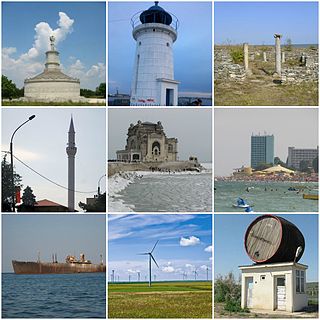
Constanța is a county (județ) of Romania on the border with Bulgaria, in the Dobruja region. Its capital city is also named Constanța.

Southern Dobruja, South Dobruja or Quadrilateral is an area of north-eastern Bulgaria comprising Dobrich and Silistra provinces, part of the historical region of Dobruja. It has an area of 7,412 square km and a population of 358,000. It was a part of Kingdom of Romania de jure from 1913 to 1918 and again from 1919 to 1940.

The Danube–Black Sea Canal is a navigable canal in Romania, which runs from Cernavodă on the Danube river, via two branches, to Constanța and Năvodari on the Black Sea. Administered from Agigea, it is an important part of the waterway link between the North Sea and the Black Sea via the Rhine–Main–Danube Canal. The main branch of the canal, with a length of 64.4 km (40.0 mi), which connects the Port of Cernavodă with the Port of Constanța, was built in 1976–1984, while the northern branch, known as the Poarta Albă–Midia Năvodari Canal, with a length of 31.2 km (19.4 mi), connecting Poarta Albă and the Port of Midia, was built between 1983 and 1987.

Adamclisi is a commune in Constanța County, in the Dobrogea region of Romania.
About 9.3% of Romania's population is represented by minorities, and 13% unknown or undisclosed according to 2021 census. The principal minorities in Romania are Hungarians and Romani people, with a declining German population and smaller numbers of Poles in Bukovina, Serbs, Croats, Slovaks and Banat Bulgarians, Ukrainians, Greeks, Jews, Turks and Tatars, Armenians, Russians, Afro-Romanians, and others.

The Germans of Romania represent one of the most significant historical ethnic minorities of Romania.
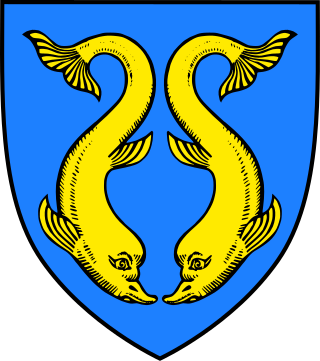
The Dobrujan Germans were an ethnic German group, within the larger category of Black Sea Germans, for over one hundred years. German-speaking colonists entered the approximately 23,000 km2 area of Dobruja around 1840 and mostly left during the relocation of 1940. Dobruja is a historical region on the west coast of the Black Sea. They are part of the Romanian Germans.

Tatars of Romania, Dobrujan Tatars or Nogay Tatars are a Turkic ethnic group that have been present in Romania since the 13th century. According to the 2011 census, 20,282 people declared themselves as Tatar, most of them being Crimean Tatars and living in Constanța County. But according to the Democratic Union of Tatar Turkic Muslims of Romania there are 50,000 Tatars in Romania. They are one of the main components of the Muslim community in Romania.

Islam in Romania is followed by only 0.3 percent of population, but has 700 years of tradition in Northern Dobruja, a region on the Black Sea coast which was part of the Ottoman Empire for almost five centuries. In present-day Romania, most adherents to Islam belong to the Tatar and Turkish ethnic communities and follow the Sunni doctrine. The Islamic religion is one of the 18 rites awarded state recognition.

The Turks of Romania are ethnic Turks who form an ethnic minority in Romania. According to the 2011 census, there were 27,698 Turks living in the country, forming a minority of some 0.15% of the population. Of these, 81.1% were recorded in the Dobruja region of the country's southeast, near the Black Sea, in the counties of Constanța (21,014) and Tulcea (1,891), with a further 8.5% residing in the national capital Bucharest (2,388).
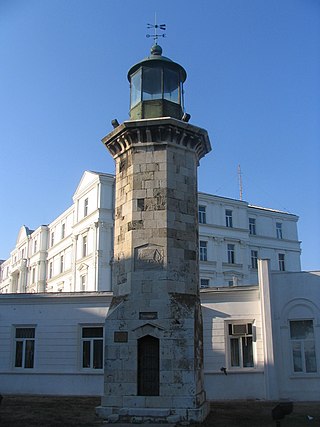
Italian Romanians are Romanian-born citizens who are fully or partially of Italian descent, whose ancestors were Italians who emigrated to Romania during the Italian diaspora, or Italian-born people in Romania.
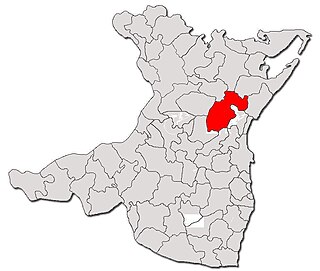
Mihail Kogălniceanu is a commune in Constanța County, Northern Dobruja, Romania, located 25 km (16 mi) northwest of Constanța proper. The commune includes three villages:

The Hungarian minority of Romania is the largest ethnic minority in Romania. As per the 2021 Romanian census, 1,150,154 people declared themselves Hungarian, while 1,182,154 people stated that Hungarian was their mother tongue.
The Circassians in Romania were an ethnic minority in the territory that constitutes modern Romania. The presence of people with names derived from the Circassians in lands belonging now to Romania was attested since at least the 15th century. For the next few centuries, these records of such people in the Romanian principalities of Moldavia and Wallachia would continue.

"Bessarabia, Romanian land", "Bessarabia is Romanian land" or "Bessarabia is Romania" is a popular and commonly used Romanian nationalist and irredentist slogan posing claims over the geographical region of Bessarabia, today divided between the Republic of Moldova and parts of Ukraine. According to the Romanian newspaper Adevărul, the use of this slogan as a patriotic catchphrase started in 2006 from a group of anonymous young Romanians from Bucharest.
![Mocanul [ro] ("The Mocan"), 1867 painting by Nicolae Grigorescu Nicolae Grigorescu - Mocanul.jpg](http://upload.wikimedia.org/wikipedia/commons/thumb/4/47/Nicolae_Grigorescu_-_Mocanul.jpg/220px-Nicolae_Grigorescu_-_Mocanul.jpg)


















